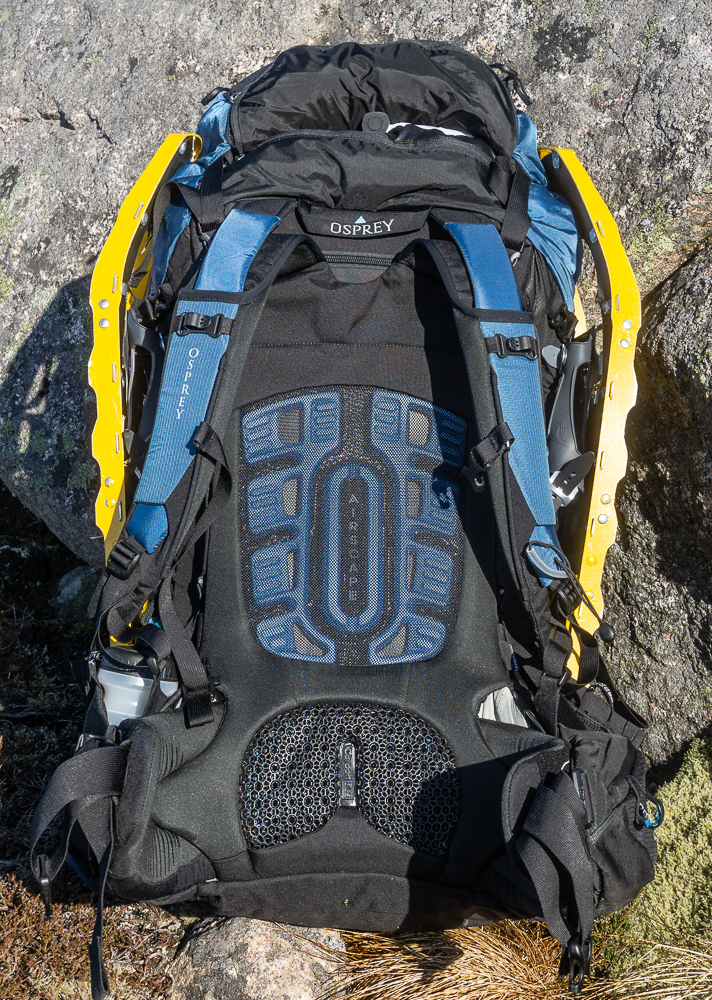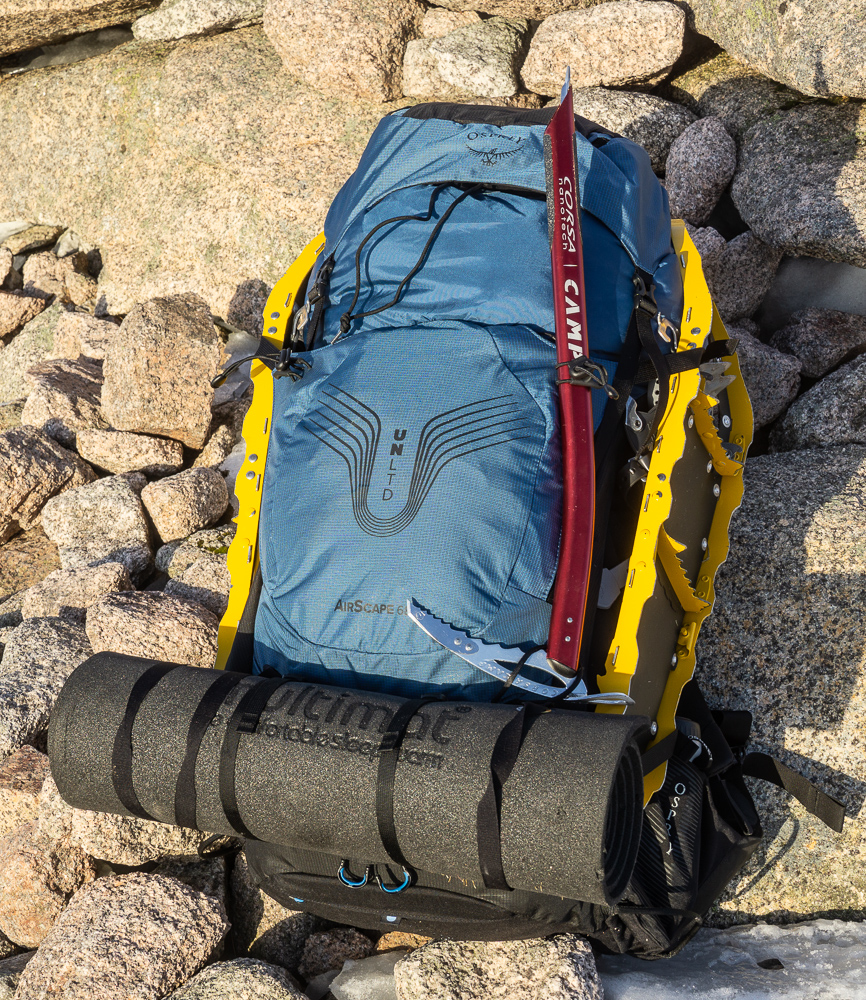This pack has an innovative back system that adjusts itself to your body – but it’s got a big price tag too.
In developing its latest packs, the UNLTD series, Osprey says it “removed the shackles of commercialization and production schedules to move beyond traditional manufacturing technologies ushering in a new era of backpack design and the ultimate backpacking experience”, which sounds impressive. But what does it mean? To find out I’ve been trying the biggest model, the AirScape 68.
Firstly, let’s look at the back system, which is quite exciting and innovative. Most interesting is the lumbar pad, which is made using Carbon DLS 3D printing technology. The result is a 3-layer lattice structure that is soft at the top, firmer in the middle, and very firm at the bottom. It also has an anti-slip surface. Osprey says the lumbar pad delivers ‘superior ventilation and fine-tuned cushion support’. The pad is linked to a thick, wide hipbelt with silicone strips on the inner surface for grip. The padded sections of the hipbelt can be adjusted in length whilst wearing the pack. The shoulder straps have an innovative autofit system. Instead of standard top tension webbing straps there are thick padded straps that slide into the lower padded shoulder straps and which adjust position as you move. Behind the harness is a mesh-covered backpanel with air channels that sits over a flexible framesheet. A stainless-steel frame runs round the edge of the back.

The packbag is one for backpackers who like multiple features. It has a single compartment with a zipped front panel that opens from the bottom and a detachable lid. There’s a compression divider in the base for sleeping bag storage. The lid has three external zipped pockets. One of these folds out to become the top half of a daypack. Combined with the detached lid this forms an 18-litre daypack for side trips away from camp. The foldout section can’t be detached. Under the lid at the back is another zipped pocket. This contains a buckled flap for covering the load if the pack is used without the lid. It too is permanently attached. And below this zipped pocket is yet another one for a hydration bladder so it can be accessed without opening the pack.
On the front of the pack there are two deep zipped pockets and on the lower sides big mesh pockets that run round the sides of the hipbelt. On one side of the latter there’s a big, zipped pocket. To finish off, the pack has side straps and base straps for compression and attaching gear, ice axe straps, and a detachable rain cover in a zipped pocket in the base.
The pack is made from high tenacity nylon with a grid of ultra-high molecular weight polyethylene (UHMWPE), a lightweight yarn with a tensile strength ten times that of steel. There are anti-abrasion panels on high-wear points. The lid and hipbelt pocket zips are water-resistant. The front pocket zips are protected by wide flaps.
A separate zipped lightweight duffle bag to protect the pack during travel is also provided. This weighs 470 grams and zips away into a small bundle.
So, the AirScape 68 is a sophisticated pack with a complex innovative back system and a multi-featured packbag. My first impressions were surprise at the weight – it’s heavy even for fully-featured big pack – and shock at the price – it’s very expensive. Does the performance justify the weight or the cost? To find out I loaded the pack up with 20kg of winter gear including snowshoes for an overnight trip on the snow-covered Cairngorm Plateau.

Adjusting the shoulder straps and hipbelt for the best fit while wearing the pack was quick and easy and once I’d done so the carry was superb. All the claims for the back system stand up. I was particularly impressed by the autofit system. On most packs I frequently need to adjust the top tension straps or shoulder straps. With the AirScape 68 I never made a single adjustment. The pack adjusted itself and always felt stable and well-balanced. The frame itself flexes to fit your back shape and adapt to your movements. It does so well. Even without the hipbelt fastened it felt right on my back. The hipbelt itself is excellent and easily supported the load. The lumbar pad never slipped or even felt like slipping and the cushioning makes it very comfortable. Ventilation is good too and my back was never sweaty. This is one of the best, perhaps the best, heavy load carriers I’ve ever used. I’d have loved this for some of my early long-distance walks with massive loads!
The crucial part of a pack for big loads, the carry system, can’t be faulted on the AirScape 68 then. Unfortunately, this isn’t the case with the packbag. Now, I prefer simpler designs without too many bells and whistle. However, if the design works well I can get along happily with more complicated packs. I found some of the features on the AirScape 68 irritating though. The side straps run across the front and side pockets, making it hard to use the latter without unclipping the straps, which isn’t ideal when you have something strapped to the side. The rear lid has twin buckles and straps on the back to attach it to the pack. Adjusting these is difficult as the buckle sections on the pack are fixed closely to the framesheet. I fumbled with cold fingers when I wanted to get a better fit for the lid after removing or adding a bulky item from the pack. These aren’t big problems, and on this trip were undoubtably exacerbated by awkwardness of the load and operating with cold fingers and gloves. But given the price of the pack I would expect near perfection.
I’d also rather the daypack section and the flap for covering the load were removable so they could be left behind on trips like this where they wouldn’t be needed. The pack is heavy enough as it is. The front panel opens from the bottom not the top, which means the pack needs to be flat on the ground to open it fully. I’d find it more useful if it opened from the top so just the upper section could be opened with the pack standing up. I ended up using just one side of it, finding it easier to put the pack on its side to access gear. The lower side straps also impede access to the panel zips, another factor that makes it easier to open from the side.
My initial impressions are good. I will be using the pack some more for another review. Overall, I’d rather see a simpler, lighter weight packbag. That said, the carrying comfort makes this an excellent pack for big loads, 20kg and upwards. It’s well-made from top quality materials and should last well. Is it worth £650? If you regularly carry very heavy loads and haven’t found a comfortable pack it could be, if money is no object.








